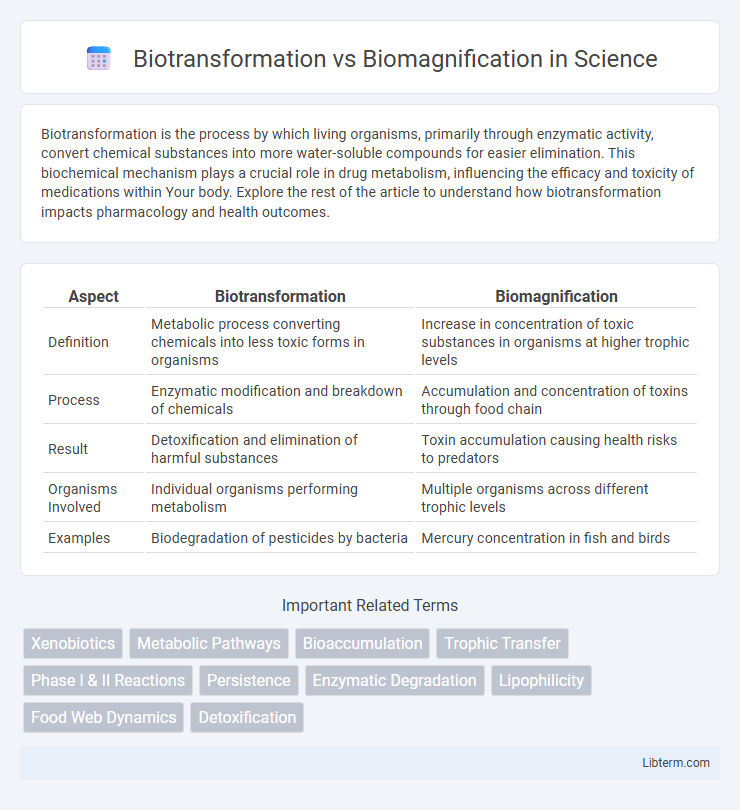Biotransformation is the process by which living organisms, primarily through enzymatic activity, convert chemical substances into more water-soluble compounds for easier elimination. This biochemical mechanism plays a crucial role in drug metabolism, influencing the efficacy and toxicity of medications within Your body. Explore the rest of the article to understand how biotransformation impacts pharmacology and health outcomes.
Table of Comparison
| Aspect | Biotransformation | Biomagnification |
|---|---|---|
| Definition | Metabolic process converting chemicals into less toxic forms in organisms | Increase in concentration of toxic substances in organisms at higher trophic levels |
| Process | Enzymatic modification and breakdown of chemicals | Accumulation and concentration of toxins through food chain |
| Result | Detoxification and elimination of harmful substances | Toxin accumulation causing health risks to predators |
| Organisms Involved | Individual organisms performing metabolism | Multiple organisms across different trophic levels |
| Examples | Biodegradation of pesticides by bacteria | Mercury concentration in fish and birds |
Introduction to Biotransformation and Biomagnification
Biotransformation refers to the chemical alteration of substances, especially toxins or drugs, within an organism through metabolic processes that convert them into more water-soluble compounds for easier excretion. Biomagnification describes the progressive increase in concentration of persistent toxins, such as heavy metals or pesticides, as they move up the food chain, resulting in higher toxin levels in apex predators. Understanding biotransformation is crucial for assessing how organisms metabolize contaminants, whereas studying biomagnification helps evaluate the ecological risks and health impacts of these accumulated toxins in ecosystems.
Defining Biotransformation in Biological Systems
Biotransformation refers to the chemical modification of compounds by living organisms, primarily through enzymatic processes that convert lipophilic substances into more hydrophilic metabolites for easier excretion. This process is crucial in reducing the toxicity and persistence of xenobiotics, such as pesticides, pharmaceuticals, and environmental pollutants, within biological systems. Unlike biomagnification, which involves the increasing concentration of contaminants in organisms higher up the food chain, biotransformation directly alters the chemical structure of substances inside individual organisms.
Understanding Biomagnification Processes
Biomagnification involves the progressive accumulation of toxic substances, such as heavy metals or persistent organic pollutants, in organisms higher up the food chain, increasing in concentration at each trophic level. This process contrasts with biotransformation, where organisms enzymatically modify contaminants into less harmful or more excretable forms. Understanding biomagnification is crucial for assessing environmental and health risks associated with bioaccumulative toxins like mercury, DDT, and PCBs in aquatic and terrestrial ecosystems.
Key Differences Between Biotransformation and Biomagnification
Biotransformation refers to the chemical alteration of substances, especially toxins, within an organism, often rendering them less harmful, while biomagnification describes the increasing concentration of toxins as they move up the food chain. A key difference lies in their biological impact; biotransformation reduces toxicity at the individual level, whereas biomagnification amplifies toxin levels across populations in an ecosystem. Biotransformation primarily occurs within organisms, whereas biomagnification is an ecological process affecting multiple trophic levels.
Mechanisms of Biotransformation in Organisms
Biotransformation in organisms involves enzymatic processes that convert lipophilic compounds into more water-soluble metabolites, facilitating their excretion. Key enzymes include cytochrome P450 monooxygenases, which introduce functional groups to xenobiotics through oxidation, reduction, or hydrolysis reactions. These biochemical modifications reduce toxicity and prevent accumulation, differentiating biotransformation from biomagnification, which refers to the increasing concentration of substances through trophic levels.
Stages and Pathways of Biomagnification
Biomagnification occurs through progressive stages where pollutants accumulate in the tissues of organisms at each trophic level, starting from primary producers to apex predators. The main pathways entail the absorption of contaminants like heavy metals and persistent organic pollutants through ingestion of contaminated food and water, leading to higher concentrations in organisms higher up the food chain. This process results in amplified toxic effects as the contaminants become more concentrated during transfer across successive trophic levels.
Environmental Impact of Biotransformation
Biotransformation plays a critical role in reducing environmental toxicity by converting harmful pollutants into less toxic or more easily excretable substances through microbial, chemical, or enzymatic processes. This natural detoxification mechanism helps mitigate the accumulation of persistent organic pollutants in soil and water, thereby protecting aquatic and terrestrial ecosystems from long-term damage. Biotransformation contrasts with biomagnification, where toxic compounds concentrate and amplify as they move up the food chain, often leading to severe ecological and health consequences.
Ecological and Health Effects of Biomagnification
Biomagnification leads to increasing concentrations of toxic substances, such as heavy metals and persistent organic pollutants, in organisms higher up the food chain, resulting in severe ecological disruptions and health risks. Elevated toxin levels in apex predators cause reproductive failures, behavioral changes, and increased mortality, while humans consuming contaminated seafood face neurological damage, immune system impairment, and heightened cancer risk. Unlike biotransformation, which can detoxify pollutants through metabolic processes, biomagnification intensifies contaminant exposure across trophic levels, amplifying harmful ecological and health impacts.
Case Studies: Biotransformation vs Biomagnification
Case studies highlight contrasting processes of biotransformation and biomagnification in ecosystems, where biotransformation involves organisms enzymatically modifying toxic substances into less harmful compounds, such as fish detoxifying mercury into less toxic forms. Biomagnification, exemplified in studies of DDT accumulation in predatory birds like eagles, shows increasing concentration of pollutants up the food chain, leading to reproductive failures. These case studies underscore the critical role of species-specific metabolic capabilities in influencing contaminant fate and ecosystem health.
Preventive Measures and Future Perspectives
Preventive measures for biotransformation and biomagnification emphasize reducing exposure to harmful chemicals through improved waste management and stricter regulation of industrial pollutants. Advances in biotechnology offer promising future perspectives by enabling biodegradation of persistent contaminants and minimizing bioaccumulation in ecosystems. Continued research into molecular pathways of toxin transformation will enhance strategies to mitigate environmental and health risks.
Biotransformation Infographic

 libterm.com
libterm.com